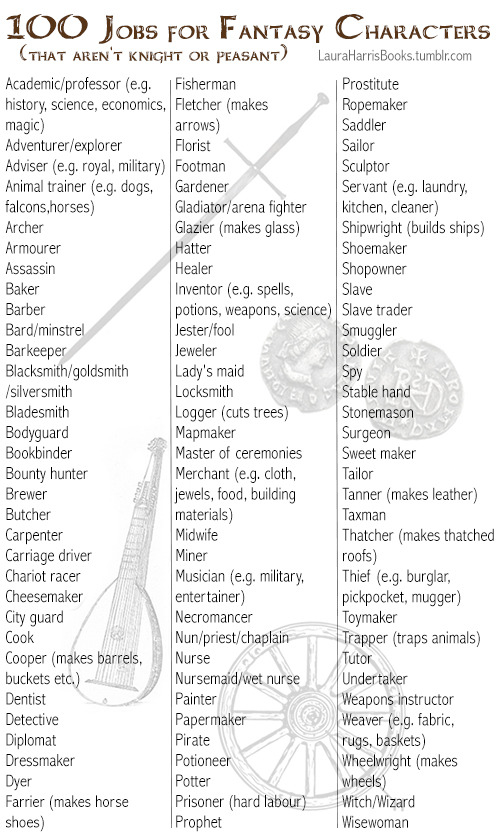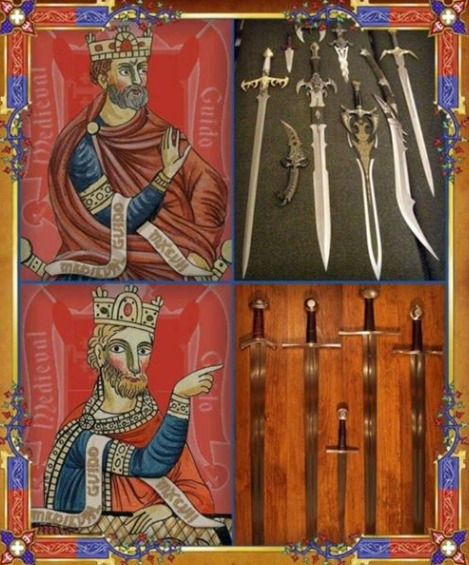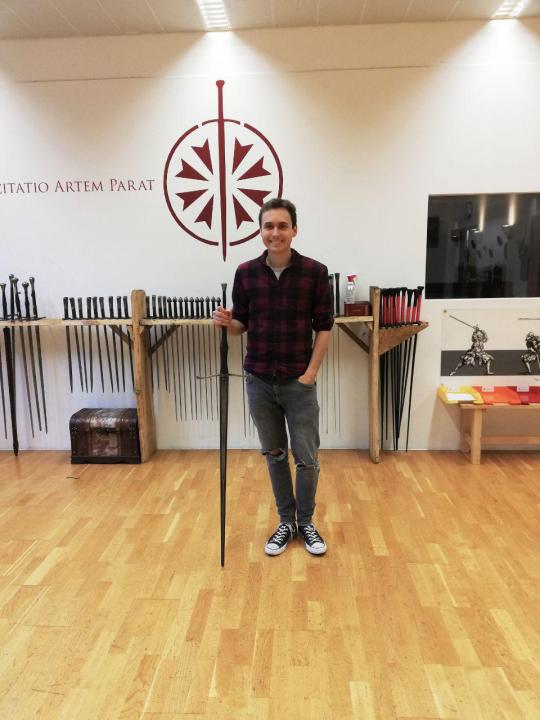world-of-orlekanu
54 posts
Writing and art sideblog full of various writing posts, inspiration, art tips and general things I'd like to keep track of. Originally a worldbuilding blog for my fantasy world so there may be a few old post kicking around
Last active 60 minutes ago
Don't wanna be here? Send us removal request.
Text
reminder to worldbuilders: don't get caught up in things that aren't important to the story you're writing, like plot and characters! instead, try to focus on what readers actually care about: detailed plate tectonics
138K notes
·
View notes
Text
LOVE failed chosen ones. Chosen ones who failed and chosen ones who aren’t special and never were and chosen ones by chance and chosen ones by a choice not their own and chosen ones who succeeded at what cost
10K notes
·
View notes
Text
bumping your OCs ages up every few years because they’re starting to feel like infants to you. reblog if you agree.
#so real#my dudes were originally like 13-15 and now they're all in their early 20s#I don't think they'll reach 30 but they might
38K notes
·
View notes
Text

50 posts!
Oh god, really... I've had this sideblog for what, four, five years? No one follows it. It's where I keep worldbuilding notes but I forget it exists and just screenshot things instead. I don't even develop Orlekanu any more, I've got a different world (though I will always love this one).
Anyway rant over. No ones gonna see anyway but if somehow you do see this, hi I guess?
5 notes
·
View notes
Text
Worldbuilding stuff:
If your story has an idle nobility class, their culture shouldn't just be different from the general population, it should be an over-the-top caricature of the common folks' culture. Whatever the population generally agrees is ideal, fair, admirable, or good, the nobility will take into stupid extremes.
Contrary to the beliefs of many, people are actually not at all happy when they're idle - a person with no assigned task or duty will go out of their way to come up with one. And all around the world, whenever there's been an upper class with nothing to do, they've started to compete with each other over stupid shit, but always stupid shit that the culture they live in considers positive qualities.
From the noblemen in Europe challenging each other to a possibly lethal duel over insulting someone's hat, to a Chinese noblewoman being moved to tears by the beauty of someone's calligraphy, bored elites everywhere have always wanted to outdo each other in their expressions of possessing all the noble traits that this culture in particular holds in value.
You can, and should, use this as a way to highlight what the actual values of this society is. In a setting where being religious is held as an admirable trait, there is nobility coming up with new ways to one-up each other in their expressions of worship. Society that values art and music will have them competing over who hires the most artists, and who employs the most talented musicians. Aggressive, war-like people will have fuels to the fucking death over a stupid hat.
Literally anything can be competed in, and bored people with far too much time and money in their hands will become competitive over the most ridiculous things. This isn't just an useful tool in worldbuilding, but also a fun one.
38K notes
·
View notes
Photo

Beyond this, consider how these professions might vary depending on who the customers are - nobles, or lower class. Are they good at their job or just scraping by? Do they work with lots of other people or on their own? City or village?
For younger characters:
Apprentice to any of the above
Messenger/runner
Page/squire
Pickpocket
Shop assistant
Student
Looks after younger siblings
(Images all from Wikimedia Commons)
205K notes
·
View notes
Text
YOU KNOW WHAT BOTHERS ME
when fantasy books describe the cloth of Quant Farmpeople’s clothing as “homespun” or “rough homespun”
“homespun” as opposed to what??? EVERYTHING WAS SPUN AT HOME
they didn’t have fucking spinning factories, your pseudo-medieval farmwife is lucky if she has a fucking spinning wheel, otherwise she’s spinning every single thread her family wears on a drop spindle NO ONE ELSE WAS DOING THE SPINNING unless you go out of your way to establish a certain baseline of industrialization in your fake medieval fantasy land.
and “rough”??? lol just because it’s farm clothes? bitch cloth was valuable as fuck because of the labor involved ain’t no self-respecting woman gonna waste fiber and ALL THAT FUCKING TIME spinning shitty yarn to weave into shitty cloth she’s gonna make GOOD QUALITY SHIT for her family, and considering that women were doing fiber prep/spinning/weaving for like 80% of their waking time up until very recently in world history, literally every woman has the skills necessary to produce some TERRIFYINGLY GOOD QUALITY THREADS
come to think of it i’ve never read a fantasy novel that talks about textile production at all??? like it’s even worse than the “where are all the farms” problem like where are people getting the cloth if no one’s doing the spinning and weaving??? kmart???
82K notes
·
View notes
Text
A problem I often seem to run in to is that I build too much too quickly and then I become overwhelmed. I have so many interlinked ideas that idk where to start because most are dependent on others.
This mostly just applied to when I'm trying to put it all down in writing, and world anvil helps so much but at the end of the day I'm just a lil gremlin with adhd and too many thoughts
#it's not even for the world this blog is supposed to be for lmao 😭#I accidentally made what started off as an elder scrolls au of sorts#But is now very much its own thing#orlekanu still lives in my brain tho
2 notes
·
View notes
Video
Magma flowing into the Pacific Ocean, Hawaii | Source
30K notes
·
View notes
Text
Writing a Blind or Visually Impaired Character
A Multi-Step Guide Written by a Visually Impaired Writer and Blogger
I’m hoping this blog will over time develop its own following, and when it does people will inevitably see my bio and notice what I included: I’m visually impaired.
Yes, a visually impaired writer, and I’ve written with two blind characters before so I have some practice in the field.
So, inevitably, someone is going to ask how to write a blind character.
Or, at least, I hope you’ll ask someone who’s actually blind or visually impaired about writing a blind character before you get too involved with your new WIP.
All parts will be tagged #blindcharacter in my blog, and I will add links to every post as I finish each part. Follow my blog for more writing advice.
Note, this post updates fairly often and old versions are still floating around out there. The most current version of this post is pinned to my blog with any new guides or links you might of missed.
As of 5 January 2021, this is the most extensive and screen reader friendly version of this post.
Part One: Crafting the Blind Character
In which I tell you how to begin making a blind character who is more than a cardboard cutout
Part Two: Narrative Choice, Visual Description, Verbal Description, Social Interaction
In which I give you a basic rundown on how to write from the perspective of a character who can’t see and still make the narration descriptive
Part Three: Tropes and Clichés to Avoid
Your blind readers will thank you for not being the 5000th person to do this and manage to actually finish your story. (Do you have any idea how many stories I’ve noped out of within two chapters because of these clichés? A Lot.)
-New- Part Four: Canes, Guide Dogs, and O&M
Everything I can tell you about 1) how to learn how to use a cane 2) how a cane works 3) how to describe what your character experiences with their cane 4) everything I know on guide dogs
Part Five: Small Aspects of being Blind You Never Thought Of
5 January 2021 Edit: This link has been fixed to correspond with the correct post
Or, really, very normal everyday things for blind people, the inclusion of which will make your characters more real and authentic. It’s the tiny details.
Part Six: Should You Cure Your Character’s Blindness? (Short Answer: No)
There’s no way to write a cure for your blind character that doesn’t make blind readers hate you. Sorry. We came here to finally experience a relatable character who experiences the world like us, but none of us are getting cured so seeing this character we learned to love become something alien from us in the end feels like a slap in the face
Writing Blind Characters Falling in Love, an Advice Post:
Someone asked what being blind and falling in love have to do with each other. Honestly, blindness changes your perspective on everything and it makes an impact on every relationship you have. This includes some things that you definitely do not want your character’s love interest to be/do.
Writing Blind Jokes (Should You Do It?)
You know those flow charts of “should you do x?” going around? It’s like that, but screen reader friendly. Should you write blind jokes. It’s pretty complicated and there are a lot of possible scenarios and details to consider.
A small essay addressing the frequently asked question on giving your blind character a superpower to help them “see.”
It’s became a popular question, so to make the answer easier/faster for everyone to access, I wrote what will usually be my initial answer. Below there are a few links to some notable past questions on this subject.
Mourning My Vision, it’s More than Depression.
A small personal essay addressing the nuances of the mourning period you experience with a new disability. The mourning period is mentioned in other guides, but this is more detailed.
Dealing with Heightened Senses, a video by Molly Burke with additional commentary by me
While Molly talks about the myths and truths about heightened senses, I talk about the correlation with blindness and neuro-divergency and how co-morbid disorders/disabilities might affect sensory processing.
Satirical Commentary on the phrase “that blank look in their eyes” used too often in fiction to identify a blind character
a:tla, I’m looking at you (and my eyes aren’t blank)
I Found a Lost Piece of Blindness History
My grandmother told me about her blind aunt and how she sent letters. It led me to speculate about all the O&M things people develop on their own but never get a chance to pass onto other blind people. Technology and techniques are lost in history and reinvented, including the white cane ad guide dogs.
Includes a little history on the introduction of guide dogs into the 20th century
The Following are Answered Anon Questions
Making Your Blog More Accessible
Making Links Accessible to Screen Readers
Reblogging to Add an Image Description to Someone Else’s Image
Why I Write Image Descriptions
Writing Blind Characters
Advice for a Character Who was Born Blind
Over-Protective Parents of a Blind Character, Why They’re Over-Protective and How to Avoid Crossing a Line
A Blind Character in Victorian Era Historical Fiction
Is It Bad Not to Have Guide Dogs in a Fantasy/Historical Setting Without Guide Dogs (short answer: it’s not bad)
Someone Asked About My Thoughts on a Medusa-like Character Blinding Herself to Avoid Hurting Anyone
-New- Characters Who Have Recently Gone Blind and Avoiding Inspiration Porn
Talking about Popular Blind Characters In Media
Does Daredevil’s Echolocation Negate His Blindness
Someone Else was Asked How to Write Daredevil Fanfiction
Blind Characters with Superpowers/Fighting Styles
World Setting where the General Population has a Superpower
Superpowers that don’t involve sight, Five questions to ask yourself if this superpower is a bad idea or a good one
-New- Your character would not use a cane as a weapon, it’s a bad idea
D&D/Roleplaying Blind Characters
-New- Animal Familiars Acting as Service Animals and Advice for Communicating with Your DM
-New- Portraying Older Blind Characters + Causes for Vision Loss with Old Age
32K notes
·
View notes
Photo


look. look at this beautiful sword meme. i’m going to cry
144K notes
·
View notes
Text
I was getting pretty fed up with links and generators with very general and overused weapons and superpowers and what have you for characters so:
Here is a page for premodern weapons, broken down into a ton of subcategories, with the weapon’s region of origin.
Here is a page of medieval weapons.
Here is a page of just about every conceived superpower.
Here is a page for legendary creatures and their regions of origin.
Here are some gemstones.
Here is a bunch of Greek legends, including monsters, gods, nymphs, heroes, and so on.
Here is a website with a ton of (legally attained, don’t worry) information about the black market.
Here is a website with information about forensic science and cases of death. Discretion advised.
Here is every religion in the world.
Here is every language in the world.
Here are methods of torture. Discretion advised.
Here are descriptions of the various methods used for the death penalty. Discretion advised.
Here are poisonous plants.
Here are plants in general.
Feel free to add more to this!
193K notes
·
View notes
Text
I took some historical sword-fighting lessons to make the fights in my novel more realistic - here’s what I learned.

To make the fighting scenes in my low fantasy novel more realistic, I went to see a trainer for historical sword-fighting last week, both to barrage her with questions and to develop realistic choreographies for the fight scenes in the novel. Since I figured some of what she told me might be useful for you too, I put together a small list for you. Big thanks to Gladiatores Munich and Jeanne for making time! (Here are some more pictures if you’re interested.)
Caveat: I’m by no means a sword-fighting expert myself, so take these nuggets with a grain of salt – I might have misremembered or misinterpreted some of the things Jeanne told me. If I did, feel free to tell me.
1.) Weapon choices need to make sense
Let’s start with a truism: always ensure your character’s weapons make sense for a.) their profession, b.) their cultural background and c.) the environment they’re going to fight in. A farmer probably couldn’t afford a sword and might use a knife or threshing flail instead, and someone who doesn’t want to be noticed probably wouldn’t be milling about sporting a glaive or another large weapon. Also, soldiers native to a country with wide open plains would be more likely to carry long-range melee weapons such as spears or large swords, than those from a country consisting of mostly jungle or dense forests. The same applies to situations: if your character is going to be fighting in close quarters (even just a normal house), he’d get little value out of a spear or even a longsword, as there’d be no space to swing it effectively.
2.) Boldness often beats skill
In real swordfights, recklessness was often more important than technique. The fighter less afraid of getting injured would often push harder, allowing them to overpower even opponents with better technique.
3.) Even a skilled fighter rarely stands a chance when outnumbered
While a skilled (or lucky) fighter might win a two-versus-one, it’d be extremely unlikely for even a single master swordsman to win against superior numbers, even just three and if they’re below his skill level. The only way to plausibly pull this off would be to split the opponents up, perhaps by luring them into a confined space where you could take them on one by one. The moment you’re surrounded, you’re probably done for – because, unlike in Hollywood, they wouldn’t take turns attacking but come at you all at once.
4.) Dual-wielding was a thing
… at least in some cultures. I often heard people say that people using a weapon in each hand is an invention of fiction. And while my instructor confirmed that she knew of no European schools doing this—if they did, it’s not well-documented—she said it was a thing in other cultures. Example of this include the dual wakizashi in Japan or tomahawk and knife in North America. However, one of the biggest problems with the depiction of dual wielding in novels/movies/games are the “windmill”-type attacks where the fighter swings their weapons independently, hitting in succession rather than simultaneously. Normally you’d always try hitting with both weapons at once, as you’d otherwise lose your advantage.
5.) Longswords were amazing
Longswords might seem boring in comparison to other weapons, but they were incredibly effective, especially in combat situations outside the battlefield. The crossguard allowed for effective blocking of almost any kind of attack (well, maybe not an overhead strike of a Mordaxt, but still), the pommel was also used as a powerful “blunt” weapon of its own that could crack skulls. Though they were somewhat less effective against armored opponents, the long, two-handed hilt allowed for precise thrusts at uncovered body parts that made up for it.
6.) “Zweihänder” were only used for very specific combat situations
Zweihänder—massive two-handed swords—were only used for specific purposes and usually not in one-on-one combat as is often seen in movies or games. One of these purposes was using their reach to break up enemy formations. In fact, one type of two-handed sword even owed its name to that purpose: Gassenhauer (German, Gasse = alley, Hauer = striker)—the fighters literally used it to strike “alleys” into an enemy formation with wide, powerful swings.
7.) It’s all about distance
While I was subconsciously aware of this, it might be helpful to remember that distance was an incredibly important element in fights. The moment your opponent got past your weapons ideal range, it was common to either switch to a different weapon or just drop your weapon and resort to punching/choking. A good example of this are spears or polearms—very powerful as long as you maintain a certain range between you and your opponent, but the moment they get too close, your weapon is practically useless. That’s also why combatants almost always brought a second weapon into battle to fall back one.
8.) Real fights rarely lasted over a minute
Another truism, but still useful to remember: real fights didn’t last long. Usually, they were over within less than a minute, sometimes only seconds – the moment your opponent landed a hit (or your weapon broke or you were disarmed), you were done for. This is especially true for combatants wearing no or only light armor.
9.) Stop the pirouettes
Unfortunately, the spinning around and pirouetting that makes many fight scenes so enjoyable to watch (or read) is completely asinine. Unless it’s a showfight, fighters would never expose their backs to their opponent or even turn their weapon away from them.
10.) It still looks amazing
If your concern is that making your fight scenes realistic will make them less aesthetic, don’t worry. Apart from the fact that the blocks, swings and thrusts still look impressive when executed correctly, I personally felt that my fights get a lot more gripping and visceral if I respect the rules. To a certain extent, unrealistic and flashy combat is plot armor. If your characters can spin and somersault to their heart’s content and no one ever shoves a spear into their backs as they would have in real life, who survives and who doesn’t noticeably becomes arbitrary. If, on the other hand, even one slip-up can result in a combatant’s death, the stakes become palpable.
That’s about it! I hope this post is as helpful to some of you as the lessons were to me. Again, if anything I wrote here is bollocks, it’s probably my fault and not Jeanne’s. I’ll try to post more stuff like this in the future.
Cheers,
Nicolas
46K notes
·
View notes
Text
all the tips I found for drawing a fantasy map are like :) “here’s a strategy to draw the land masses! here’s how to plot islands!” :) and that’s wonderful and I love them all but ??? how? do y'all decide where to put cities/mountains/forests/towns I have my map and my land but I’m throwing darts to decide where the Main Citadel where the Action Takes Place is
96K notes
·
View notes
Text
Myths, Creatures, and Folklore
Want to create a religion for your fictional world? Here are some references and resources!
General:
General Folklore
Various Folktales
Heroes
Weather Folklore
Trees in Mythology
Animals in Mythology
Birds in Mythology
Flowers in Mythology
Fruit in Mythology
Plants in Mythology
Folktales from Around the World
Africa:
Egyptian Mythology
African Mythology
More African Mythology
Egyptian Gods and Goddesses
The Gods of Africa
Even More African Mythology
West African Mythology
All About African Mythology
African Mythical Creatures
Gods and Goddesses
The Americas:
Aztec Mythology
Haitian Mythology
Inca Mythology
Maya Mythology
Native American Mythology
More Inca Mythology
More Native American Mythology
South American Mythical Creatures
North American Mythical Creatures
Aztec Gods and Goddesses
Asia:
Chinese Mythology
Hindu Mythology
Japanese Mythology
Korean Mythology
More Japanese Mythology
Chinese and Japanese Mythical Creatures
Indian Mythical Creatures
Chinese Gods and Goddesses
Hindu Gods and Goddesses
Korean Gods and Goddesses
Europe:
Basque Mythology
Celtic Mythology
Etruscan Mythology
Greek Mythology
Latvian Mythology
Norse Mythology
Roman Mythology
Arthurian Legends
Bestiary
Celtic Gods and Goddesses
Gods and Goddesses of the Celtic Lands
Finnish Mythology
Celtic Mythical Creatures
Gods and Goddesses
Middle East:
Islamic Mythology
Judaic Mythology
Mesopotamian Mythology
Persian Mythology
Middle Eastern Mythical Creatures
Oceania:
Aboriginal Mythology
Polynesian Mythology
More Polynesian Mythology
Mythology of the Polynesian Islands
Melanesian Mythology
Massive Polynesian Mythology Post
Maori Mythical Creatures
Hawaiian Gods and Goddesses
Hawaiian Goddesses
Gods and Goddesses
Creating a Fantasy Religion:
Creating Part 1
Creating Part 2
Creating Part 3
Creating Part 4
Fantasy Religion Design Guide
Using Religion in Fantasy
Religion in Fantasy
Creating Fantasy Worlds
Beliefs in Fantasy
Some superstitions:
Keep reading
314K notes
·
View notes



